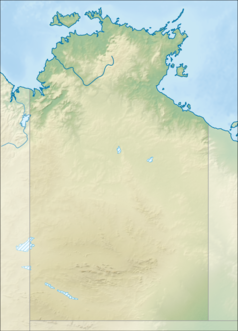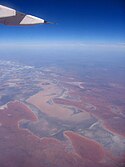Amadeus (jezioro)
 zdjęcie lotnicze | |
| Położenie | |
| Państwo | |
|---|---|
| Terytorium | |
| Morfometria | |
| Powierzchnia | 880 km² |
Lake Amadeus – płytkie, bezodpływowe, słone jezioro o powierzchni 880 km² położone w południowo-zachodniej części Terytorium Północnego w Australii. Zajmuje płytkie koryto napełnione osadami naniesionymi z Gór Macdonnella od północy i Musgrave od południa.
Co jakiś czas po ulewnych deszczach napełnia się wodą na kilkanaście cm słupa wody. W porze letniej wysycha. Ma ok. 145 km długości i ok. 20 km szerokości. W porze suchej na jego dnie tworzy się warstwa playa, czyli twardych osadów zmieszanych z solą o gładkiej powierzchni lub samej soli.
W niedalekiej odległości znajduje się sławny pomnik kultury Aborygenów: Uluru, czyli Ayers Rock.
Media użyte na tej stronie
Autor: , Licencja: CC BY-SA 3.0
Relief map of Australia, including the borders of the states of the Commonwealth of Australia
The flag of the Northern Territory (adopted on July 1, 1978 on the first day of self-government) was designed by the Australian artist Robert Ingpen, of Drysdale Victoria, after consultation with members of the community at the invitation of the Northern Territory Government. The flag incorporates the three official Territorian colours of black, white and ochre and is divided into two panels, black at the hoist side taking up one third the length of the flag while the remainder is equal to two third the length of the flag in ochre. The black panel display the five white stars that form the constellation of the Southern Cross, using the Victorian configuration of the Southern Cross with stars having between five to eight points. The flag also features the official Northern Territory floral emblem on the red ochre panel, a stylisation of the Sturt's Desert Rose, which uses seven petals encircling a seven-pointed black star of the federation in the centre. The seven petals symbolises the six Australian states plus the Northern Territory. The Northern Territory Flag was the first official flag that did not contain the Union Jack.
Autor: Tzugaj, Licencja: CC0
znak graficzny do map, ukazujący przykładowe jezioro
Autor: Tentotwo, Licencja: CC BY-SA 3.0
Relief location map of the Northern Territory, Australia Equidistant cylindrical projection, latitude of true scale 17.75° S (equivalent to equirectangular projection with N/S stretching 105 %). Geographic limits of the map:
- N: 10.6° S
- S: 26.5° S
- W: 127.5° E
- E: 139.5° E
Lake Amadeus, Northern Territory, Australia – seen from a plane







